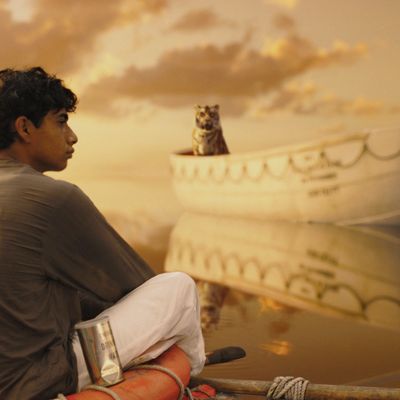
For Life of Pi, the overcontrolled director Ang Lee has gone with his strengths and made a movie thatÔÇÖs passionately overcontrolled. It takes place largely on a lifeboat adrift in the South Pacific that carries radically mismatched buddies: a skinny 16-year-old Indian vegetarian with the odd name ÔÇ£PiÔÇØ (Suraj Sharma) and a man-eating Bengal tiger with the even odder name ÔÇ£Richard Parker.ÔÇØ The lifeboat isnÔÇÖt entirely lifelike, mind you. The waterÔÇÖs aquamarine is more like ultra-ultramarine, the sea a mirror in which clouds above seem to mingle with sharks, dorados, luminous jellyfish, even whales below. Later, on an island thatÔÇÖs mysteriously alive, the orange of the tiger burns especially bright in the chlorophyll-green forest of the ebony-black night.
Life of Pi looks neither natural nor egregiously fake but vivid, as if a knob had been turned way up on the color of each objectÔÇÖs spirit and the real world into a sort of pantheistic storybook. And thatÔÇÖs exactly the right look for what it is: a tale told by the older Pi (Irrfan Khan) to a writer (Rafe Spall) who has sought him out after hearing that Pi had a story to make him ÔÇ£believe in God.ÔÇØ IÔÇÖm not sure how I felt about God at the end of Life of Pi, but I fervently believed in the magic of movies.
Some of that magic comes from the 3-D, which Lee shows off in the first seconds of the credit sequence. In an Indian zoo owned by PiÔÇÖs parents, the camera lingers on paintings of animals on walls that bear a striking resemblance to cave paintingsÔÇöand then look out, the animalsÔÇÖ 3-D counterparts are suddenly cominÔÇÖ at ya. Those cave painters would freak out. But thereÔÇÖs also something old-fashioned about LeeÔÇÖs frames. He holds the shots for a long time, longer than any major American studio head would let him if not for that marvelously immersive technology. Armed with 3-D, Lee can slow the storytelling down without worrying about modern audiences getting antsy. And he has Mychael DannaÔÇÖs score, one of DannaÔÇÖs East-West hybrids (Persian flutes and gamelan weaving in and out of Romantic orchestrations), providing a sense of flux when the images are static. That lifeboat goes nowhere fast.
PiÔÇÖs god (God, gods) is (are) also in flux: HeÔÇÖs a polymath, a Hindu who thanks Lord Vishnu for introducing him to Christ while rolling out his prayer mat to honor Allah. This kid subscribes to everything ÔÇö and this in the face of his fatherÔÇÖs blunt reliance on reason and insistence that creatures like the tiger (which gazes into PiÔÇÖs eyes and sees only lunch) have no souls. PiÔÇÖs own faith in the Higher Power(s) gets the test of his or anyoneÔÇÖs life when the ship bound for North America bearing his family and their animals (theyÔÇÖre emigrating) goes down along with most of the living things onboard. The audience, meanwhile, witnesses the uplifting arrival of the god of cinema.
In one fluid motion, a zebra (it must be CGI, but who can tell?) leaps crazily into the lifeboat and lands with a terrible, backbreaking thud. ThereÔÇÖs an orangutan grieving for a lost child, and hiding under a tarpaulin is the pieceÔÇÖs real villain, a madly carnivorous hyena. Richard Parker swims aboard and carnage ensuesÔÇöthough far less explicit than the corresponding passages of Yann MartelÔÇÖs novel. Left alone with each other and their dwindling supplies of food, Pi and Parker achieve a tense d├®tente, though let it be said that Lee, like Martel, goes all out to avoid even a whiff of family-friendly anthropomorphosizing. Despite that name, Richard Parker remains an animal in circumstances known to turn the most civilized human into a beast. Dread forestalls dearness. Life of Pi evokes MelvilleÔÇÖs mordant answer to the Transcendentalists in Moby-Dick: You might sit astride a mast and feel a oneness with nature, but fall into the sea and youÔÇÖll be quickly digested. Even those clunky interludes with the grown-up Pi and the interviewer (poor Spall, with so little to play) end up paying off. The movie has a sting in its tail that puts what youÔÇÖve seen in a startlingly harsh context.
It turns out Lee has more affinity for Pi the yarn-spinner than for any of his other heroes. His movies (Lust, Caution; Crouching Tiger, Hidden Dragon; Hulk; Brokeback Mountain; Taking Woodstock) center on emotions that canÔÇÖt be suppressed and finally burst forthÔÇöbut the meticulousness of his framing and color-coordination (or that mythical cowboy iconography in Brokeback Mountain) make his work seem one step removed, as if in a terrarium. In Life of Pi, he finally has a story in which that very distance is the source of the emotion. Pi has designed his own terrarium to keep from staring directly into the abyss. ItÔÇÖs not denial. ItÔÇÖs faith in something else: the transformative power of storytelling. The film is transcendent.
This review first appeared in the Nov. 26, 2012 issue of New York Magazine.


